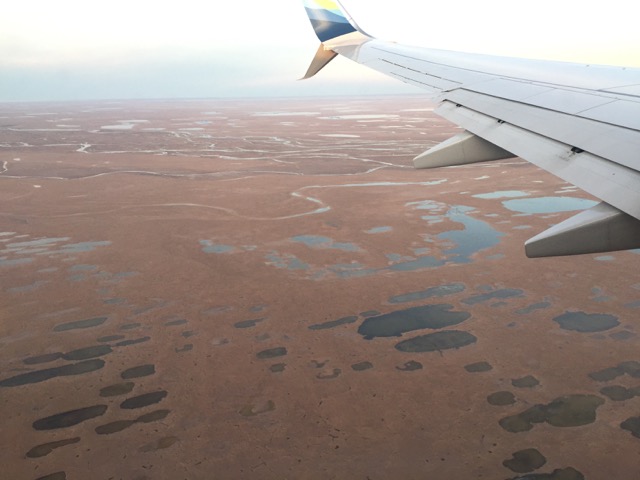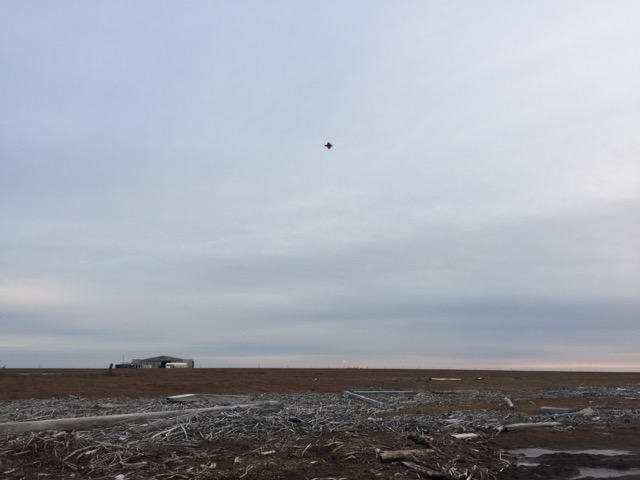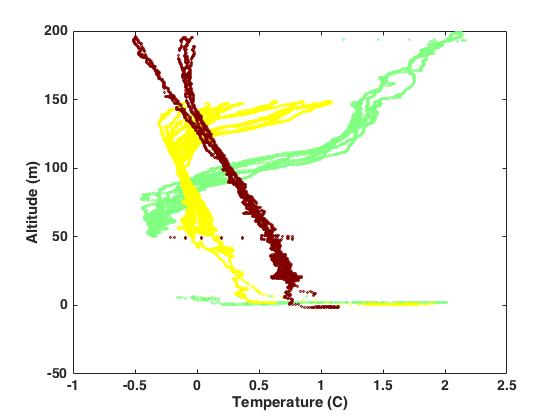
The summer-like scene on final approach to Deadhorse. Other than the fact that it’s clearly tundra, it doesn’t exactly look like the Arctic in mid-October!
This morning, Matt, Carl, Steve and I departed Anchorage for Deadhorse. Along the way we saw some additional familiar faces – Joe Hardesty, part of the Sandia team; Joshua Remitz, part of the tech team for the ARM mobile facility; and Jessica Cherry from the University of Alaska – Fairbanks were all on the same morning flight! The flight itself was uneventful – despite an 8 am takeoff time, it was still quite dark. At the latitude of Oliktok Point we are going to lose nearly 2 hours of daylight over the course of the upcoming two weeks! After arriving at Deadhorse we picked up our rental truck from Delta Leasing and made the ~2 hour drive to Oliktok Point. Interestingly, it kind of looks like summer up here — many of the ponds and lakes are still open, there is no snow at all on the tundra, and the coastal waters are completely ice-free!
After we arrived at the site things got interesting. The plan for today was to arrive on site, get re-acquainted with the surroundings, and prepare equipment for a first flight day tomorrow. However, looking at the weather forecast, things are supposed to get very windy tomorrow, and given the nice, calm conditions today, and thanks to Al Bendure’s forward thinking in activating the restricted airspace a day earlier than originally planned, we scrapped our original plan and moved as quickly as possible to get a plane airborne today! After a quick orientation, we unpacked some equipment, started charging batteries, and Steve worked feverishly to get a single DataHawk built and ready for action! While Steve was working, the rest of the group made a quick run to the “NOC” (Nikiatchuq Operations Center — the ENI-petroleum run camp in which we’re staying for the next two weeks) to check in and grab some lunch. When we got back to the AMF-3 (DOE ARM mobile facility), Steve had finished assembling the aircraft and we headed out to the runway for our first flight!

Al (front) and Steve (back) during one of our flights today. The plane was flying very well, so it was all smiles!

Steve monitoring the DataHawk while it completes autonomous flights. You know it’s going well when the pilot’s hands are in his pockets!
I’m really happy to say that we got three very successful flights in this afternoon. All of them were in the ~30 minute range, and they included profiles up to 200 m, some low altitude (20 m) flights over the water, and a bit of scouting of spatial variability along the coastal gradient. It was an interesting time to be flying, as conditions were definitely shifting from the calm, southerly winds that we started the day with, to a stronger east-northeasterly wind by the end of the afternoon. By the last flight, we saw some winds aloft which were blowing at nearly 15 meters per second! Also, we saw a clear evolution of the boundary layer structure during this time, with the airplane first observing a deep stable layer reaching from near the surface all the way up to 200 m, which then was quickly eroded as the wind direction shifted to one coming off of the water surface.

A DataHawk surveys the Arctic sky over Oliktok Point.

Profiles from today’s flights. The green points were from the first flight of the day, while the red points were from the last. Over the course of a few hours, the stable layer aloft was quickly eroded by a well-mixed boundary layer structure resulting from off-ocean flow.
Tomorrow (and the next couple of days, for that matter) looks to be windy, so I’m not sure we’ll get to fly again soon. However, the forecast is continuing to show lighter winds by Friday of this week, so it’s not looking nearly as gloomy as last time, weather-wise. In some ways, the winds will give us a good reason to get the rest of our ground work done tomorrow – building the other planes, calibrating sensors, double checking all of our instruments, etc. It will be busy regardless of the winds!!

Hallo Gijs,
Leuk om je weer op de pool te kunnen volgen. Ik hoop dat er veel dagen zijn dat je gegevens kunt verzamelen. Sterkte met het werk en … hou de ijsberen een beetje op afstand.
Hartelijke groet,
Geert